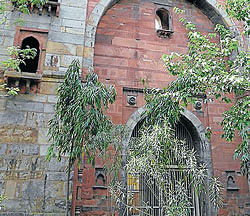Few who pass by the Khooni Darwaza on Bahadur Shah Zafar Marg, know of its bloodied history.

A monument in the middle of a busy street in cosmopolitan Delhi, Khooni Darwaza is a living legend of the gore and violence which our long history has seen.
Located opposite the Ferozeshah Kotla ruins, this is not just a ‘darwaza’ or a gateway, but a mini fortress in itself. 15.5 metres high and made of Delhi quartzite stone this monument has three staircases leading to different levels of the gate.
An open structure at one time, today it is sealed for entry from all sides. This, after the monument was in news some years ago following the gang rape of a student of Maulana Azad Medical College, situated across the road.
Kanika Singh, a PhD scholar in history and a member of the Delhi Heritage Walks club informs, “Khooni Darwaza was built during Sher Shah Suri’s time in 16th century.
Back then it was known as Kabuli Darwaza because caravans to Afghanistan used to pass through the Northern gate of Suri’s capital city which had Purana Qila as its central citadel. Besides providing direction, this gateway served another purpose - its walls were used to display heads of criminals since it was situated on the outskirts of the city.”
It acquired the name ‘Khooni Darwaza’ during the Mughal period after Jehangir had two sons of Abdur Rahim Khan-i-Khanan, a minister in his father Akbar’s court, killed and hung on this gate. Jehangir was angry with Khanan for having supported his elder brother Khusrau’s claim to the throne after Akbar's death.
History repeated itself when Aurangzeb defeated his elder brother Dara Shikoh in a war of succession and had Dara’s head displayed here.
Much later in 1857, the sons of Bahadur Shah Zafar - Mirza Mughal and Mirza Khizr Sultan and grandson Mirza Abu Bekar were murdered at the gate by Major Hodson -a British officer after Bahadur Shah's surrender. Hodson was bringing the princes from Humayun's Tomb in Nizamuddin. Near Khooni Darwaza he panicked as a crowd of at least 3000 had gathered by then, and shot the three princes without provocation. He then had the bodies of the princes stripped naked and laid infront of the Kotwali in Chandni Chowk. They lay there for days altogether rotting.
Khooni Darwaza saw much bloodshed even as late as 1947 when during riots refugees were murdered here while moving towards a camp in Purana Qila.
Even today, residents in the area claim to see blood stains on the walls of this monument even though that is most probably just the red colour of the stone used in the monument.
Deccan Herald is on WhatsApp Channels| Join now for Breaking News & Editor's Picks